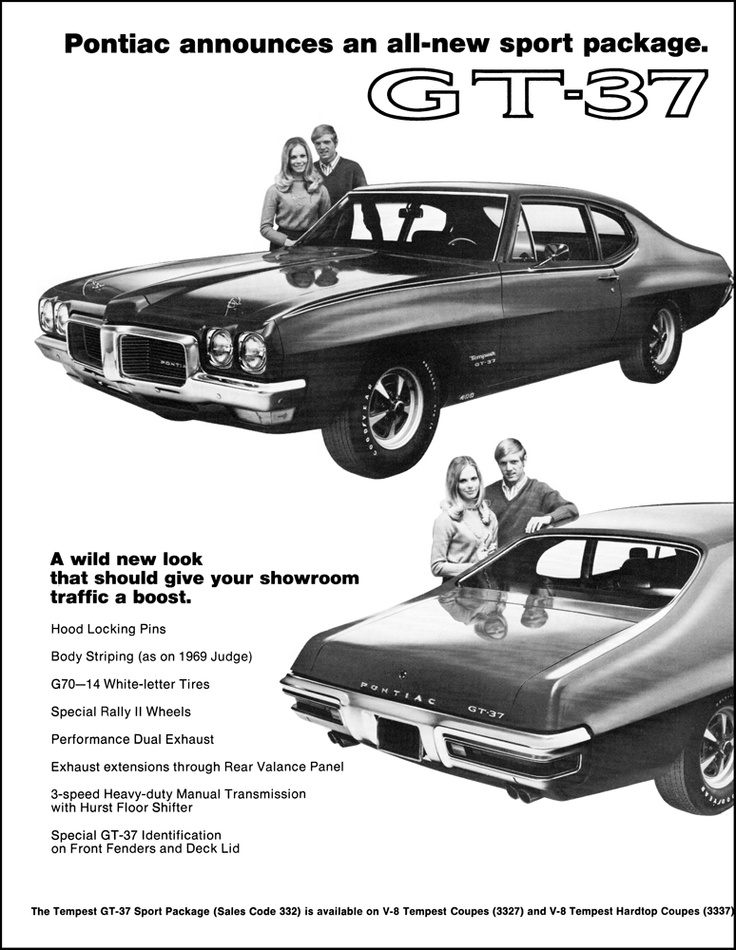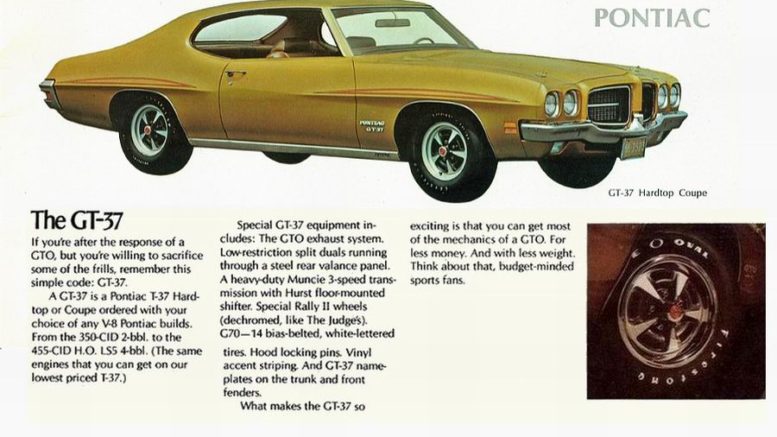Q: Greg I have a 1971 Pontiac GT-37 and it has the eyebrow decals over the wheel wells like the GTO had. I am debating on selling it but the more I research about the car, I’m having second thoughts.
I came across your article on the Pontiac T-37 and GT-37 and the way I see it is the GT-37 is rarer than a T-37. The body is in great shape, but it has no motor. I do have a ‘68 350 Pontiac motor with a Muncie 4-speed that I could use. I guess the reason I’m writing you is I really want to know if you feel this is a rare muscle car as I’ve been told by a couple of people that it is. Thank you, Twingles, via email.
A: Twingles, you are indeed in possession of a rare Pontiac muscle car from the “real deal” muscle car years of 1962 to 1972. However, before you decide to sell, consider these facts.

In 1971, a Pontiac T-37 could be ordered with a 455 H.O. V8 engine, 4-speed M22 Muncie “rock crusher” and 4:33 rear gears. Non-GT models known as the T-37 were also stripped Pontiac Lemans models that came with a cloth bench seat and rubber floor mats.
It was a pretty plain car, and intentionally built that way for a main reason, namely insurance premiums. Interesting is that the GTO Judge was also promoted as a stripped down version of the “regular” GTO, although nowhere near the T-37. Pontiac’s T-37 actually arrived mid-year 1970 as the muscle car revolution was just starting to slow down due to very high muscle car insurance premiums. Thus, if you wanted a GTO, the insurance company premiums were sky-high if teenagers or under 30 years of age drivers were on the policies. So, Pontiac used vehicle identification from the non-performance car Tempest coupled with 37 identification to fall under Pontiac Tempest insurance rates, which were much lower than a GTO/Judge. As for nomenclature, “T” stood for Tempest and “37” was the Pontiac internal code for any and all hardtop coupes across the line.
The initial ‘70 Pontiac GT-37 was the most powerful Pontiac muscle car produced when equipped with the Ram Air III 400-inch engine that put out a conservative 345 horses. Other V8s were available, but the 400 Ram Air was the hot ticket.

Notable is that even though the GT-37 had the Ram Air III engine, no ram air hood was available and just 1,419 GT-37 coupes were built in 1970. A note here is that the GT option cost $236.97 and included Judge style accent stripes, Rally II wheels minus the trim rings, white letter tires, dual exhaust, 3-speed manual floor-mounted shifter, remote mirrors, hood pins, and the GT-37 nameplate. This 1970 GT option was solely for exterior sprucing up and did not include any additional performance engine options.
However, in 1971, things changed.
The Tempest was no longer available, so Pontiac used its identical 112-inch Lemans chassis for the T-37 models and its corresponding lower insurance premiums. Further, the 1971 models were 100 pounds lighter in the two-door models. A four-door T-37 was also available, but its wheelbase was four inches longer and not suited for muscle car enthusiast.
Your GT option for ’71 included a Hurst shifter and again any GTO style engine could be ordered, including that 350 you have sitting in your garage, which was the base engine on the GT-37. As for marketing, Pontiac even utilized the saying “There’s a little GTO in every GT-37, and you don’t have to be over 30 to afford it,” again in regards to the high under 30 year-old driver insurance rates for the GTO.
The most powerful engine option was the $358 more H.O. 455, rated at just 335 horses but putting out more. Overall T37 production came in at near 36,000, of which 5,802 were V8s. But of the V8s, only 54 had the 455 H.O. engine, making the 455 powered GT-37 the rarest of all.
Since your GT-37 has the two white decals on the fenders, it is clearly a hot “37” that warrants some serious consideration as to NOT selling it.
You mention you have a Muncie 4-speed, which came in M21 (wide ratio) and M22 (close ratio) “rock crusher” formats on the ’71 T-37s. Originally, the GT-37 had some serious muscle under the hood and the 455 V8 M22’s were the best of the GM four-speeds at the time and stood up to speed shifting better than any other resulting in its “rock crusher” slang. (I had one on my ’68 Camaro SS/RS L78 396/375 and it held up well under my relentless speed shifting.)
In summary, few high performance 37s are around these days so if haven’t yet sold your GT-37, I’d seriously think twice before letting it go. If all you can afford is the 350 engine at this point, it will still show very well at the car shows. But if you can put together either a 400 or 455 V8 and use your Muncie 4-speed you’ll be the owner or a very rare Pontiac muscle car that is going up in value.
Good luck.
(Greg Zyla is a syndicated auto columnist who welcomes reader questions on collector cars at greg@gregzyla.com or at 303 Roosevelt St., Sayre, Pa. 18840)



Be the first to comment on "Collector Car Corner – 1971 Pontiac GT-37 worthy of restoration and how it ‘fooled’ the insurance companies "